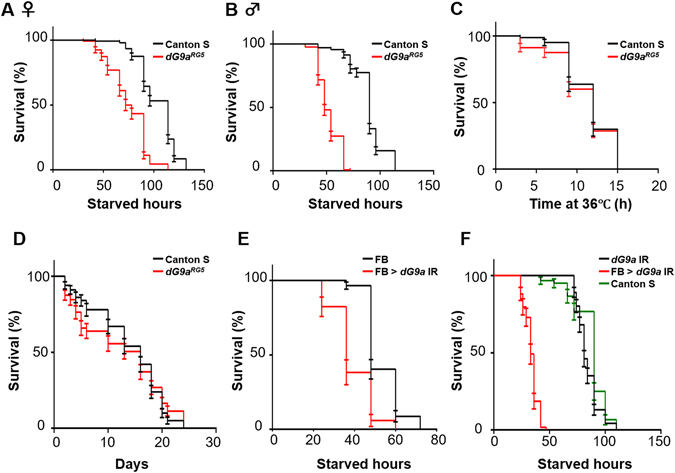Figure 1.

dG9a is critical for survival under starvation stress. (A) The results of a viability assay under starvation conditions using females of the wild-type (Canton S) (n = 153 from 8 independent experiments) and dG9a null mutant (dG9aRG5) (n = 135 from 7 independent experiments) P < 0.0001 (B). The results of a viability assay under starvation conditions using males of the wild-type (n = 131 from 7 independent experiments) and dG9a null mutant (dG9aRG5) (n = 138 from 7 independent experiments) P < 0.0001. (C) The results of a viability assay under heat stress using males of the wild-type (n = 80 from 4 independent experiments) and dG9a null mutant (dG9aRG5) (n = 80 from 4 independent experiments) P = 0.41. (D) The results of a viability assay under oxidative stress using males of the wild-type (n = 100 from 5 independent experiments) and dG9a null mutant (dG9aRG5) (n = 97 from 5 independent experiments) P = 0.80. (E) The results of a viability assay under starvation conditions using males of the FB (+; FB-GAL4; +) (n = 57 from 3 independent experiments) and FB > dG9a IR (w; UAS-dG9a IR/FB-GAL4; +) (n = 34 from 2 independent experiments) P < 0.0001. (F) The results of a viability assay under starvation conditions using males of the FB > dG9a IR (w; UAS-dG9a IR/FB-GAL4; +) (n = 59 from 3 independent experiments), males of the dG9a IR (w; UAS-dG9a IR/+; +) (n = 92 from 5 independent experiments) and males of Canton S (n = 60 from 3 independent experiments). dG9a IR and Canton S: P > 0.05. (A–F) Error bars represent standard errors (SE).
